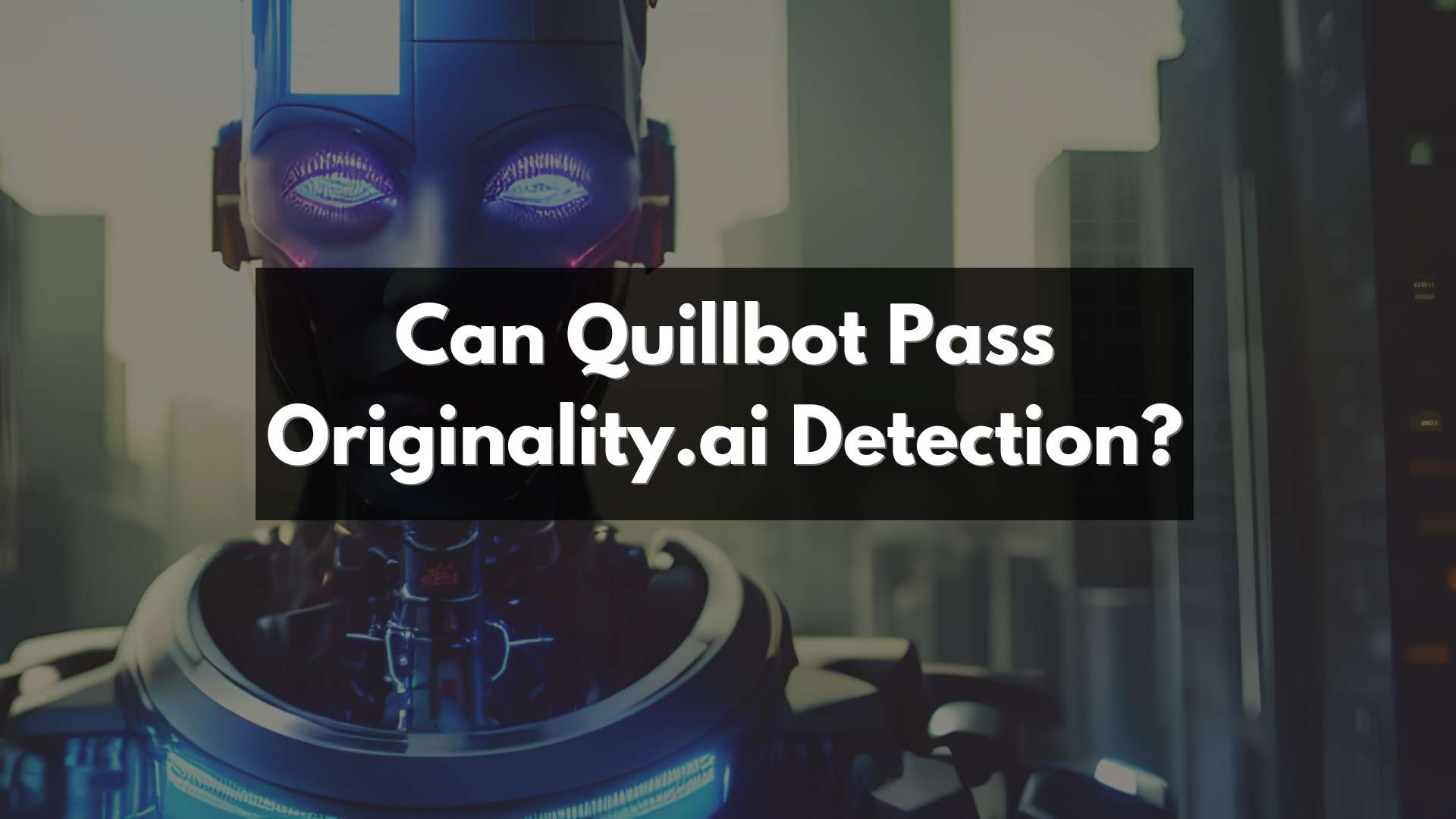Can Quillbot Pass Originality.ai Detection?
Are you curious about whether content created with Quillbot can bypass the sharp eyes of Originality.ai? You’re not alone as this has been a burning question for many in the field of academic writing and SEO.
This blog post will shed light on how Quillbot and plagiarism checkers like Originality.ai operate, offering insightful tactics to utilize such tools while maintaining integrity. Dive in, let’s unlock some AI secrets!
Key Takeaways
- Quillbot has the potential to pass Originality.ai detection by incorporating various strategies such as using acceptable text sources, employing different synonyms, reordering sentences, and utilizing sophisticated AI writers.
- Factors that can impact Originality.ai’s ability to detect Quillbot-generated content include the choice of text sources, length of passages, use of synonyms, sentence reordering, and utilization of advanced AI algorithms.
- However, it is important to note that there is no absolute guarantee that Quillbot-generated content will always pass plagiarism checkers like Originality.ai. Proper citation and careful revision are crucial to maintain academic integrity and avoid potential issues with copyright infringement.
- Relying solely on QuillBot for content creation poses risks such as the need for proper citation and the necessity to thoroughly revise the generated content for accuracy and quality.
What is Originality. ai Detection
Originality.ai Detection is a tool that analyzes written content to determine its uniqueness and detect any instances of plagiarism.
Overview of how Originality.ai works
Originality.ai is a powerful tool for detecting plagiarism, utilizing advanced artificial intelligence to analyze content. It works by conducting a comprehensive text similarity analysis, searching for exact matches of words or phrases, and identifying similar grammatical patterns within the content.
This entails breaking down the submitted document in such a way that it can match phrases and patterns with billions of documents available on the internet databank. What sets Originality.ai apart from its competitors like Turnitin is its sophisticated algorithm which focuses not only on phrase matching but also on similarities in grammatical patterns, making it much harder to evade detection by simply altering a few words here and there.
Factors that impact Originality.ai’s ability to detect
Originality.ai’s ability to detect content can be influenced by several factors, including:
- Text sources used: The choice of acceptable text sources can impact the effectiveness of Originality.ai detection. If Quillbot uses reliable and diverse sources for generating content, it may be less likely to be flagged as plagiarized.
- Length of passages: Longer passages that have been generated by Quillbot are generally more difficult for Originality.ai to identify as potentially plagiarized. This is because the algorithm may struggle to recognize extended sections of text that have been paraphrased or rephrased.
- Use of different synonyms: Quillbot has the capability to use various synonym suggestions when generating text. By incorporating a range of synonyms, Quillbot can create content that deviates enough from the original source material, making it more challenging for Originality.ai to detect similarities.
- Sentence reordering: Another factor affecting Originality.ai’s detection capabilities is the reordering of sentences within the generated content. By rearranging sentences, Quillbot can further modify the structure and flow of the text, reducing the likelihood of detection.
- Utilizing sophisticated AI writers: The use of advanced AI algorithms within Quillbot plays a significant role in its ability to pass Originality.ai detection. These sophisticated models enhance language processing and provide better context understanding, improving the chances of creating unique content that evades plagiarism checkers.
How QuillBot Tries to Pass Originality.ai Detection
QuillBot tries to pass Originality.ai detection by employing different synonyms, reordering sentences, and utilizing sophisticated AI writers to create content that is unique and plagiarism-free.
Longer passages are harder to detect
Longer passages of text generated by Quillbot are more challenging for plagiarism detection tools to identify. This is because the longer the passage, the greater the chances that specific words or phrase matches are diluted within a larger context.
Plagiarism checkers often rely on identifying exact word or phrase matches, but with longer passages generated by Quillbot, these similarities in grammatical patterns become less apparent.
Therefore, using longer passages can help increase the likelihood of passing Originality.ai detection and other plagiarism-checking algorithms.
Use different synonyms
QuillBot can increase its chances of passing Originality.ai detection by incorporating different synonyms into its generated content. Here’s how:
- Utilize a diverse vocabulary and employ various synonyms for words and phrases throughout the text.
- Incorporate alternative language choices to avoid exact word or phrase matches in plagiarism checkers.
- Explore different expressions and idiomatic phrases to make the content unique.
- Apply synonymous terms that maintain the original meaning but offer a fresh perspective.
- Opt for less common synonyms to further differentiate the text from existing sources.
- Employ QuillBot’s advanced AI capabilities to suggest alternative word choices that are less likely to be flagged.
Reorder sentences
Reordering sentences is another effective strategy to help QuillBot pass Originality.ai detection. By rearranging the order of sentences in the generated content, it can minimize similarities with the original source and reduce the chances of plagiarism detection. Here’s how reordering sentences can aid in achieving higher originality:
- Shuffle sentence placement: Rearrange the sequence of sentences in the text to create a different flow and structure. This helps to break up any potential patterns that could be identified by plagiarism detection algorithms.
- Mix up paragraph organization: Similarly, reshuffling paragraphs within the content can contribute to making it less recognizable by plagiarism checkers. By altering paragraph order, you can introduce variations that improve content originality.
- Use transitional phrases: Incorporating transitional phrases like “however,” “meanwhile,” or “on the other hand” between reordered sentences can enhance coherence and prevent detection algorithms from identifying exact word matches.
- Experiment with synonym usage: While QuillBot already provides paraphrased versions of text, manually substituting certain words or phrases with synonyms can further diversify the language used in the content, making it less prone to detection.
- Maintain readability and coherence: While reordering sentences, ensure that the meaning and overall logic of the generated content remain intact. The goal is to make subtle modifications while preserving clarity and cohesiveness.
Use sophisticated AI writers
Sophisticated AI writers are a key strategy for ensuring that Quillbot-generated content can pass Originality.ai detection. These advanced AI models, such as GPT and ChatGPT, have the ability to generate more complex and natural-sounding text.
By utilizing these sophisticated AI writers, Quillbot can produce content that is less likely to be flagged by plagiarism checkers like Turnitin or Originality.ai. This approach allows for greater flexibility in creating unique and original content while still benefiting from the efficiency and convenience of using an AI-powered writing tool like Quillbot.
Risks Of Relying On QuillBot
Relying on QuillBot for content creation poses several risks, including the need to ensure proper citation and the potential for having to revise QuillBot-generated content.
Academic integrity is also a concern when using AI-powered writing tools like QuillBot, and it’s important to understand how to properly utilize them.
Ensuring proper citation
Proper citation is crucial when using content generated by Quillbot or any other AI writing tool. It’s important to attribute the original source of information or ideas to avoid plagiarism and maintain academic integrity.
This means providing accurate references for quotes, paraphrases, and any other borrowed material. It’s also essential to follow the specific citation style required by your institution or publication, such as APA or MLA format.
By ensuring proper citation, you can confidently use Quillbot-generated content while giving credit where it’s due and avoiding copyright infringement.
Revising QuillBot-generated content
When using QuillBot to generate content, it is important to thoroughly revise the output to ensure its accuracy and quality. Here are some key steps to follow when revising QuillBot-generated content:
- Read through the entire content: Start by reading through the entire content generated by QuillBot. This will help you get an overall understanding of the text and identify any potential areas for improvement.
- Check for grammatical errors: Pay close attention to grammar, punctuation, and spelling errors. Make necessary corrections to ensure that the content reads smoothly and professionally.
- Verify factual information: Double-check any facts or statistics mentioned in the generated content. Cross-reference with credible sources to ensure accuracy and avoid spreading misinformation.
- Enhance readability: Consider the tone and style of writing appropriate for your target audience. Make adjustments as needed to enhance clarity, coherence, and flow of the text.
- Maintain consistency: Ensure consistency in terminology, formatting, and referencing throughout the content. This includes consistent use of headings, subheadings, citation styles, etc.
- Add a personal touch: Inject a personal touch by incorporating your own insights and perspective into the revised content. This will make it more unique and tailored to your specific needs.
- Use plagiarism checker: Run the revised content through a reliable plagiarism checker to verify its originality and ensure it does not unintentionally contain plagiarized elements.
- Seek feedback: If possible, have someone else review your revised content for a fresh perspective and constructive feedback.
Maintaining academic integrity
Maintaining academic integrity when using Quillbot or any AI writing tool is crucial to avoid plagiarism. While these tools can be helpful in generating content, it’s important to ensure proper citation and revision of the Quillbot-generated output.
Academic integrity software such as Turnitin and Originality.ai can still detect similarities in grammatical patterns or exact word matches, so relying solely on Quillbot for creating original content may pose risks.
To maintain academic integrity, users should carefully review and revise the content generated by Quillbot, ensuring that it meets the required standards and properly citing any borrowed information.
Proper use of QuillBot
To ensure the proper use of QuillBot, it is important to understand its limitations and take certain precautions. First and foremost, when using QuillBot-generated content, it is crucial to always provide proper citation and give credit where it is due.
While QuillBot can assist in paraphrasing and text transformation, it does not replace the need for careful revision and editing. It’s essential to review any content generated by QuillBot to make sure it aligns with your desired tone, style, and purpose.
Additionally, maintaining academic integrity should be a top priority when using AI-powered writing tools like QuillBot. Properly attributing sources, avoiding plagiarism, and adhering to ethical guidelines are important aspects of responsible content creation.
Conclusion
In conclusion, while there is a possibility that Quillbot can pass Originality.ai detection, it is not assured. Factors such as the use of acceptable text sources, longer passages, different synonyms, and sentence reordering can increase the chances of bypassing plagiarism checkers.
However, it is essential to exercise caution and ensure proper citation and revision of Quillbot-generated content to maintain academic integrity. Ultimately, using Quillbot must be done responsibly and ethically to avoid potential risks associated with plagiarism detection algorithms like Originality.ai.
FAQs
Can Quillbot pass Originality.ai detection?
Quillbot is designed to help users generate unique content, but its ability to pass Originality.ai detection can vary depending on the specific use case and requirements. It’s always recommended to double-check the generated content using plagiarism detection tools to ensure compliance with originality standards.
Does Quillbot have a high success rate in passing plagiarism checks?
Quillbot has been developed with advanced algorithms that aim to produce unique and original content. While it generally performs well in avoiding plagiarism, its success rate in passing plagiarism checks ultimately depends on factors like the input given, language nuances, and potential similarities among existing sources.
How can I maximize the originality of content generated by Quillbot?
To enhance the originality of content generated by Quillbot, it’s advisable to provide clear instructions, precise specifications or guidelines for desired outcomes. Additionally, reviewing and editing the output produced by Quillbot ensures that any inadvertent similarities are removed or modified accordingly.
Are there any precautions I should take when using Quillbot for creating content?
While Quillbot is a helpful tool for generating content efficiently, it’s essential to exercise caution when relying solely on automated solutions. Always review the output for accuracy and quality while employing additional proofreading measures like manual editing and fact-checking before finalizing any work.






